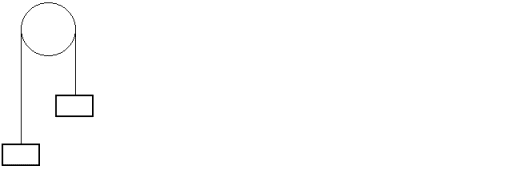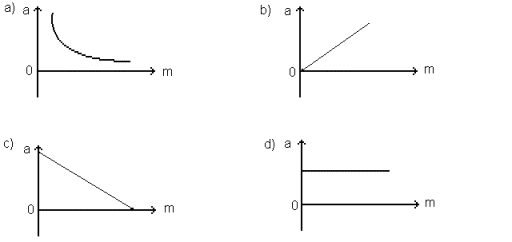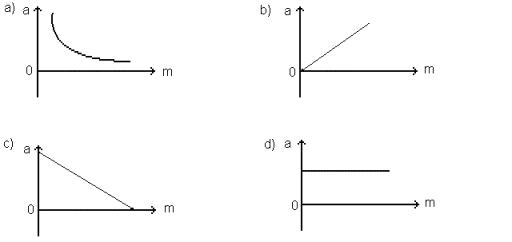
B.
Newton’s Laws Take Home Quiz
300 points (33
questions worth 9.09 points each)
1.
Galileo's Law of Inertia is the same as
a. Newton's First Law.
b. Newton's Second Law.
c. Newton's Third Law.
d. Kepler's Law.
2.
You are standing in a moving bus, and you suddenly fall backward.
You can imply from this that the bus's
a. velocity increased.
b. velocity decreased.
c. speed remained the same, but it's
turning to the right.
d. speed remained the same, but it's
turning to the left.
3.
It's more difficult to start moving a heavy carton from rest than it is
to keep pushing it with constant velocity, because
a. the normal force (N) is greater
when the carton is at rest.
b. µs < µk
c. initially, the normal force (N)
is not perpendicular to the applied force.
d. µk < µs
4.
A packing crate slides down an inclined ramp at constant velocity.
Thus we can deduce that
a. a frictional force is acting on
it.
b. a net downward force is acting on
it.
c. it may be accelerating.
d. it is not acted on by appreciable
gravitational force.
5.
You fall, while skiing, and one ski (of weight W) loosens and slides down
an icy slope (assume no friction), which makes an angle q with
the horizontal. The force that
pushes it down along the hill is
a. zero; it moves with constant
velocity.
b. W
c. W cos q
d. W sin q
6.
When you sit on a chair, the resultant force on you
a. is zero.
b. is up.
c. is down.
d. depends on your weight.
7.
When you sit on a chair, the reaction to your weight is:
a. the chair pushing on you
b. your push down on the chair
c. the earth being pulled up
d. zero if in equilibrium
8.
A book can slide down a frictionless hill at constant velocity.
a. True
b. False

9.
If two identical masses are attached by a light cord passing over a
massless, frictionless pulley of an Atwood's machine, but at different heights,
and then released,
a. the lower mass will go down.
b. the higher mass will go down.
c. the masses will not move.
d. the motion will depend on the
amount of the masses.
10.
An astronaut is inside a space capsule in orbit around the earth. She is
able to float inside the capsule because
a. her weight is zero, and her
capsule's weight is zero.
b. her weight is zero, and her
capsule is accelerating.
c. she and her capsule move with the
same constant velocity.
d. she and her capsule move with the
same acceleration.

11.
The same horizontal force is applied to objects of different mass.
Which of the graphs illustrates the experimental results?
a. graph A
b. graph B
c. graph C
d. graph D

12.
Which graph illustrates the result of a net force proportional to mass?
a. graph A
b. graph B
c. graph C
d. graph D
13.
When the rocket engines on the starship NO-PAIN-NO-GAIN are suddenly
turned off, while traveling in empty space, the starship will
a. stop immediately.
b. slowly slow down, and then stop.
c. go faster and faster.
d. move with constant speed.
14.
If you exert a force F on an object, the force which the object exerts on
you will
a. depend on whether or not the
object is moving.
b. depend on whether or not you are
moving.
c. depend on the relative masses of
you and the object.
d. be F in all cases.
15.
A child's toy is suspended from the ceiling by means of a string.
The earth pulls downward on the toy with its weight force of 8 N. If this is the "action force," what is the
"reaction force"?
a. The string pulling upward on the
toy with an 8-N force.
b. The ceiling pulling upward on the
string with an 8-N force.
c. The string pulling downward on
the ceiling with an 8-N force.
d. The toy pulling upward on the
earth with an 8-N force.
16.
Your mass on the moon will be about one-sixth of your mass on earth.
a. True
b. False
17.
The moon pulls on the earth with one-sixth of the force of the earth
exerted on the moon.
a. True
b. False
18.
An arrow is shot straight up. At
the top of its path, the net force acting on it is
a. greater than its weight.
b. greater than zero, but less than
its weight.
c. instantaneously equal to zero.
d. equal to its weight.
19.
A block of mass M slides down a frictionless plane inclined at an angle q with
the horizontal. The normal reaction
force exerted by the plane on the block is
a. Mg
b. Mg sin q
c.
Mg cos q
d.
zero, since the plane is frictionless.
20.
Florence, who weighs 120 lb, stands on a bathroom scale in an elevator.
What will she see the scale read when the elevator is accelerating upward
at 2.0 m/s2?
a. 120 lb
b. 144 lb
c. 156 lb
d. 96 lb
e. 86 lb
21.
A decoration, of mass M, is suspended by a string from the ceiling inside
an elevator. The elevator is
traveling upward with a constant speed. The
tension in the string is
a. equal to Mg.
b. less than Mg.
c. greater than Mg.
d. impossible to tell without
knowing the speed.

22.
A train consists of a caboose (mass = 1000 kg), a car (mass 2000 kg), and
an engine car (mass 2000 kg). If
the train has an acceleration of 5.50 m/s2,
then the tension force in the coupling between the middle car and the engine car
is
a. 27.5 kN
b. 16.5 kN
c. 11.0 kN
d. 5.50 kN
e. none of these

23.
Two identical masses are attached by a light string that passes over a
small pulley, as shown. The table and the pulley are frictionless.
The masses are moving
a. with an acceleration less than g.
b. with an acceleration equal to g.
c. with an acceleration greater than
g.
d. at constant speed.
24.
If you push a 4-kg mass with the same force that you push a 10-kg mass
from rest,
a. the 10-kg mass accelerates 2.5
times faster than the 4-kg mass.
b. the 4-kg mass accelerates 2.5
times faster than the 10-kg mass.
c. both masses accelerate at the
same rate.
d. none of the above is true.

25.
Two cardboard boxes full of books are in contact with each other on a
table. Box H has twice the mass of
box G. If you push on box G with a
horizontal force F, then box H will experience a net force of
a. 2/3 F
b. F
c. 3/2 F
d. 2 F

26.
A toolbox, of mass M, is resting on a flat board.
One end of the board is lifted up until the toolbox just starts to slide.
The angle é that the board makes with
the horizontal, for this to occur, depends on the
a. mass, M.
b. acceleration of gravity, g.
c. coefficient of kinetic friction, µK.
d. coefficient of static friction, µs.
27.
A horizontal force of 5 N accelerates a 4-kg mass, from rest, at a rate
of 0.5 m/s2 in the positive direction.
What friction force acts on the mass?
a. +3 N
b. -3 N
c. +2 N
d. -2 N

28.
A 16-kg fish is weighed with two spring scales, each of negligible
weight, as shown here. What will be
the readings on the scales?
a. Each scale will read 8 kg.
b. The sum of the two readings will
be 32 kg.
c. The top scale will read 16 kg,
and the bottom scale will read zero.
d. The bottom scale will read 16 kg,
and the top scale will read zero.
e. Each scale will show a reading
greater than zero and less then 16 kg, but the sum of the two readings will be
16 kg.
29.
An object is dropped from a helicopter.
When it reaches terminal velocity
a. gravity no longer acts upon it
b. all of the upward forces add up
to zero
c. the acceleration finally reaches
g
d. the total force is zero
30.
The kinetic friction of one object sliding along another surface depends least
upon:
a. the normal force
b. the area of contact
c. the coefficient of kinetic
friction
d. the nature of the materials in
contact
31.
Work done by STATIC FRICTION is always:
a. negative
b. positive
c. along the surface
d. zero
32.
Planning to elope with her boyfriend, Janice slides down a rope from her
fourth story window (how romantic).
As she slides down the rope, she tightens harder on the rope which of
course increases the tension in the rope. When
the upward tension in the rope equals Janice's weight:
a. Janice will slow down
b. Janice will come to a complete stop
c. Janice will continue down at
constant speed
d. Janice will speed up
e. the rope will break.
33.
Which is usually larger?
a. kinetic coefficient of friction
b. static coefficient of friction
c. neither